
The rugged region of red rock
The highlight of this region is Twyfelfontein – Namibia’s first World Heritage Site – with its wealth of rock engravings. Other special attractions are the majestic Brandberg with its treasure trove of ancient San rock art and daunting backpacking challenges, the Petrified Forest, Burnt Mountain, Organ Pipes, the Spitzkoppe, and the Erongo Mountains.

TWYFELFONTEIN AND SURROUNDINGS
Namibia’s first World Heritage Site (status awarded in 2007), Twyfelfontein (meaning doubtful fountain), is a massive, open-air art gallery that is of great interest to international rock-art connoisseurs. The 2,000-plus rock engravings, estimated to be 6,000 years old, represent one of Africa’s largest and most noteworthy concentrations of rock art.
Contemporary research suggests that the creators of the rock art were San medicine people or shamans who went into an altered state of consciousness and connected with the spiritual world when a trance was induced. This could be used for purposes such as rain-making and healing the sick. The engravings depicted the images they saw after returning to normal consciousness.
About 50 km away is the Petrified Forest, where a cataclysmic event millions of years ago deposited giant tree trunks that subsequently turned to stone. Today the Namib’s living fossil plant, Welwitschia mirabilis, grows among these prostrate fossilised trunks. South of Twyfelfontein is the Burnt Mountain, a panorama of desolation with coloured rocks contrasting vividly against the grey-black surroundings. The Organ Pipes, a mass of vertical basalt columns in a ravine gouged out by a river, is another geological curiosity in the area. Southwest of Twyfelfontein is the Doros Crater, where fossil remains have been found among the rocks.

Organ Pipes

Welwitschia mirabilis
MESSUM CRATER
Fine specimens of the desert plant, Welwitschia mirabilis, can be seen at the Messum Crater southwest of the Brandberg.
Between 132 and 135 million years old, Messum has a diameter of 18 km. Messum is regarded as a volcanic feature that forms part of the Goboboseb Mountains to the northeast. It dates from the Etendeka period and, according to geologists, was the source of many of the intrusive and quartz-like extrusive rocks found in the area today. The crater was named after Captain W Messum, who was an explorer of the coastal regions of Southern Africa, which he surveyed from the ocean between 1846 and 1848.
While driving to the Messum area you should, however, not overlook the lichen fields. The western part of Messum lies in the Dorob National Park and you will need a permit, obtainable at the Henties Bay Tourism Association.


THE BRANDBERG
The imposing Brandberg massif is a challenge to hikers, especially its peak, Königstein, which at 2 573 metres is the highest point in Namibia.
The Brandberg is famous for the White Lady painting which can be seen on an overhang in Maack’s Shelter, named after the surveyor who first reported
it in 1918. Maack’s Shelter lies in the Tsisab Gorge, a wild and beautiful ravine located amongst a vast jumble of rocks that are remnants of manyancient landslides. Although the figure of the White Lady, surrounded by paintings of numerous animals, has faded over the years, a pilgrimage tosee it is well worth the effort. Walks to the shelter are conducted daily by National Heritage Council guides from 08h00 until 16h30 when the last walk departs. The round-trip takes around two-and-a half hours and is best done early in the morning. This massive outdoor gallery has been nominated for proclamation as a UNESCO World Heritage Site.
The Senegalia montis-usti trees, conspicuous in the Brandberg valley, are endemic to this region.
The 8 083 km2 Tsiseb Conservancy in the Uis and Brandberg environs is the second-largest conservancy in Namibia. The small town of Uis has a Multi-Purpose Information Centre, with a coffee shop and Internet facilities, enabling travellers between Swakopmund and Etosha to access information about the entire region and to book tours with the Dâureb Mountain Guides to climb the Brandberg.
To preserve the extremely rich rock painting heritage of the Brandberg, hikers planning to ascend the mountain must be accompanied by a guide provided by the National Heritage Council. The guides know the mountain intimately, including where to find water which can be achallenge for those unfamiliar with the Brandberg. The National Heritage Council (NHC) of Namibia has announced:
• A letter of permission issued by the NHC is required by a person or group before hiking and camping on the mountain. In order to obtain a letter simply contact the NHC in Windhoek requesting permission. Their number is 061 244 375 and they are located at 52 Robert Mugabe Avenue in Windhoek.
• You need to indicate the number of days you will stay and how many are in the group.
• A permit is required for any other activities such as research or filming.
For more information contact the National Heritage Council directly at www.nhc-nam.org or
+264 61 244 375.
SPITZKOPPE
The Spitzkoppe is a group of rounded granite mountains situated northwest of Usakos, en route to Swakopmund. A favourite with climbers, the Spitzkoppe peak – affectionately known as Namibia’s Matterhorn because of its resemblance to the famous Swiss mountain – was first climbed in 1946. The Spitzkoppe group peaks at 1 728 metres above sea level. Seventy metres above the surrounding gravel plains are Sugarloaf Mountain and the Pondok Mountains (resembling the rounded Damara huts called pondoks). Rising 600 metres above the Kaokoveld plains, the main inselberg (island mountain) of the Spitzkoppe is approximately 700 million years old.
After good summer rains, tall grass sways on the plains and small pools of water collect on the granite rocks of the mountain in shallow hollows. The group also has a minor peak, Little Spitzkoppe, which extends into the Pondok Mountains. On the eastern side is Bushman’s Paradise, with a walk up the steep incline made possible by the use of a fixed steel cable. Remains of San paintings can be seen in the overhang. Unfortunately, like most rock art in the Spitzkoppe area, they have been vandalised.
Other rock paintings can be seen at the Small Bushman’s Paradise and Golden Snake sites. At the Spitzkoppe turn-off, where the D1918 meets the B2, is the popular Ûiba-Ôas Crystal Market. Here the local community sells a variety of crystals, gemstones and minerals. The market is open seven days a week.
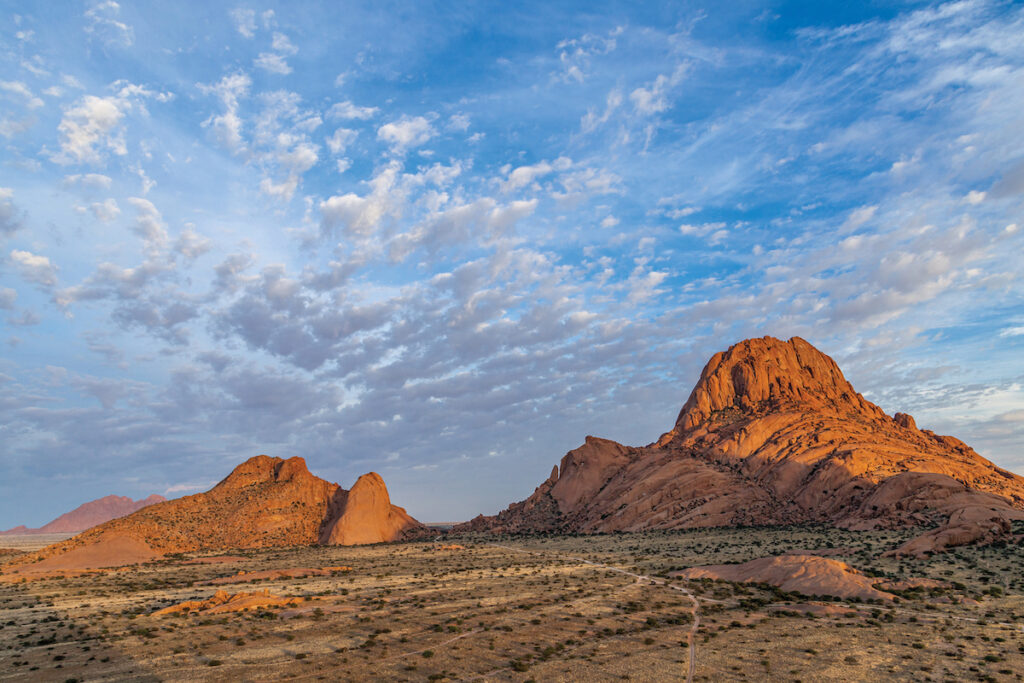
Khorixas, the unofficial capital of the former Damaraland, is a useful stopover for refuelling your vehicle and stocking up on basic supplies. Although the town itself has little to offer, the surroundings feature rare and unusual rock formations, ancient rock engravings and strange geological wonders, tempting geologists and many other travellers to the region. Near the hot-water spring at Warmquelle is Sesfontein Fort. A desolate and rapidly disintegrating ruin for many years, it has been reconstructed and equipped to accommodate tourists. Sesfontein derives its name from the six fountains that have their source in the vicinity. The palm trees at the fort were planted by colonial German police officers who manned it to combat weapon smuggling and elephant and rhino poaching. Close by is Signal Hill, a lookout point, where a heliograph station was constructed by German troops.
Dominating the landscape when travelling westwards en route to Khorixas, 95 km west of Outjo, is the Ugab Vingerklip (Finger Rock) situated amongst the rugged Ugab Terraces. About 35 metres high, this distinctive monolith was shaped by erosion spanning many millennia.
Although not offering much in terms of tourism, the small settlement of Kamanjab’s Pots of Hope project
is well worth a visit. Here, a group of rural women and young people combine their skills to create unique, hand-made pottery items. Founded by Alexia /Naris, the project supports poor, stigmatised and abused women and girls, providing them with an alternative means of income based on their creative skills. The girls and women create products ranging from vases, tea sets and milk jugs to garden pots, goblets and plates.
Omaruru in central Namibia is a splendid example of a town that continues to reinvent itself and thrive in the process. Having evolved in recent years as a haven for an active artists’ community, it is a small town with big ideas.
Like many towns in Namibia, it originated as a mission station. The missionary Hugo Hahn was the first European to set foot here. When Omaruru was besieged by Herero forces during the Herero/German war, it was freed by Captain Victor Franke and his men. The Franke Tower, built to commemorate this event, was inaugurated in 1908. The oldest building in Omaruru, the Old Rhenish Mission House, now serves as the town museum. At the Namibia Stone Processing plant, items from local marble and granite are manufactured.
In 1907 Omaruru officially acquired municipality status. By this time Willi Wronsky had built his residence, today’s Wronsky House, at the north end of Wilhelm Zeraua Road; the small Roman Catholic Church on Wilhelm Zeraua Road had been built and dedicated; and the Omaruru River had run above ground for the entire winter, most unusual in this dry part of the country.
Every year the artists’ community of Omaruru presents an Artists’ Trail. Over the first weekend in September, open studios and outdoor exhibits draw visitors to Namibia from around Southern Africa and beyond. During 2009 the Omuntu Garden was opened with an exhibition of over 50 sculptures by five Namibiansculptors. The creator of Omuntu, Hanne Alpers, maintains the garden as a permanent display area for sculptural art. Omuntu means ‘human being’ in Oshiwambo.
The Main Street Café is open for breakfast and lunch. It specialises in home-made fare, including cheese, cheesecake and sausages made with locally sourced ingredients.
Local crafts and small industries
On the south-western edge of town you will find Tikoloshe Afrika, a vibrant gallery and workshop where visitors can watch award-winning woodcarvers in action. In an open-air studio they transform weather-worn roots and tree trunks into unique sculptures of animals, varying in size from 10 cm to 10 metres high. Kashana Landhaus is a group of buildings on the banks of the Omaruru River initiated by local artists to accommodate studios and creative outlets such as the jewellery design workshop of German-trained goldsmith Annette Meyer, and Heavenly Herbs, a shop devised by local artist, Hanne Alpers, who also owns the Naua Naua Art shop and gallery on the same premises.
Since June 2004, the Kristall Kellerei in Omaruru has been manufacturing its own brandy. It also produces wines, which compare favourably to international standards. A range of Schnapps is distilled from prickly pears, prosopis roots, lemons and, naturally, grapes. Well worth a visit is the Erongo Mountain Winery situated on the fringe of town along the Omaruru River. The boutique winery is open for personal tours and tastings of their interesting and innovative wines and spirits.
Rock paintings
The area surrounding Omaruru is rich in rock paintings. The Erongo Mountains and the area surrounding Omaruru are extremely rich in rock paintings; among them Omandumba Guest Farm. At Etemba there are six main sites with rock paintings. The largest of these is the Etemba Cave, where a large number depict humans and animals.
Incorporating the Erongo Mountains and western escarpment, the Erongo Mountain Nature Conservancy extends over approximately 200 000 hectares, encompassing one of the most environmentally diverse areas in Namibia, and including cultural artefacts such as rock paintings, rock engravings and prehistoric settlements. The region harbours high densities of leopard and brown hyaena. The members of the conservancy are committed to reintroducing species that formally inhabited the area, such as black-faced impala and black rhino. In terms of endemic species, the Erongo environment is one of Namibia’s hotspots, as it hosts a vast array of endemic and near-endemic plant, reptile, bird and mammal species. These include the Angolan dwarf python, White-tailed Shrike, Hartlaub’s Spurfowl, Ruppell’s Parrot, Rockrunner and Hartmann’s zebra. Rare species that have found refuge in the Erongo Mountains include the Peregrine Falcon and Booted Eagle. The striking Verreaux’s Eagle can also be seen breeding in the mountains.
Known for the marble extracted at a nearby quarry, the small town of Karibib lies en route to Walvis Bay and Swakopmund. The marble and granite mined at the Karibib Marble Works is used commercially for tombstones and to enhance public buildings and private homes in Namibia. It is also exported to countries such as the USA, China, Italy and Thailand for building purposes. An interesting place to visit in Karibib is the Henckert Tourist Centre on the main street, an ideal refreshment stop for travellers between Windhoek and Swakopmund. The Navachab Gold Mine southwest of the town was established in 1987, two years after the discovery of gold on Navachab Farm. The gold is of a relatively low quality, however, as 750 000 tonnes of rock must be processed every year to make the enterprise viable.
Brought to life by the construction of the railway line between Swakopmund and Windhoek, one of the oldest buildings in Karibib, the Rösemann Building, was built in 1900. It serves as an excellent example of the German architecture of the period, and is still in use today, housing a bank and some shops. The Hotel Zum Grünen Kranze, situated in Main Street and built in 1913, was one of six hotels in the town during the German colonial period. Hälbich House serves as the only reminder of the firm G Hälbich & Co (founded in 1873), the oldest trading company in the history of Namibia, and an integral role player in the development of Karibib. Another interesting building is Haus Woll, constructed with granite and marble sourced from the area. It was built at the beginning of the 20th century as a residence for Georg Woll.
Other heritage buildings of interest are the Kubas Station Building, a white marble building erected in 1900, serving as a station building for the German State Railway until 1914; and the Proviantamt (Provisions Office), built in 1911 as a quartermaster’s store. The latter is currently used by the Karibib Marble Works.
Situated at the northern edge of the town is Kaiserbrunnen, a water reservoir and drinking trough built in 1906. The well has since dried up.
South of Karibib is a small, dusty, almost-forgotten village called Otjimbingwe, a name thought to mean ‘place of refreshment’ and referring to a spring in the Omusema River.
Yet Otjimbingwe was proclaimed the administrative centre of the then Deutsch-Südwestafrika during German colonial occupation. A mission station was established here in 1849, and the first church was built in 1867.
Historical features in the town include the Hälbich Trading Store, the Rhenish Mission Church, the Powder Magazine erected in 1872 to protect the local population against attacks by the Nama, and the old Windmill, which generated power for the wagon factory belonging to the Hälbich family.
After Curt von Francois moved his garrison to Windhoek in 1890, the town began to fall into decline, and when the railway line between Windhoek and Swakopmund was completed in the early 1900s, Otjimbingwe was bypassed and soon fell into obscurity.
The small sun-baked town of Usakos, nestled in the valley of the Khan River, developed around a station on the old narrow-gauge railway built in 1900. Beyond Usakos is the Trekkopje Battlefield, site of one of the most important battles fought during the short-lived 1915 campaign waged by South African against German forces.
The Erongo Mountains north of the town are renowned for the rock art found at sites. A popular stopover for visitors to and from the coast, the Namib Oasis farm stall is well known for its homemade biltong and droëwors, home-cooked meals and handmade gifts.
Accommodation

Ai-Aiba – The Rock Painting Lodge
Dramatically set against imposing granite boulders in the foothills of the Erongo Mountain range lies Ai Aiba Lodge. Famous for its countless rock painting sites, Ai-Aiba is a mystical exploration of nature. The lodge with its high thatched roof restaurant, lounge, pool and thatched mountain facing chalets, is an oasis surrounded by tall palms and

Brandberg White Lady Lodge
You have travelled! You have seen places! Brandberg White Lady Lodge will add to your travel experience through Damaraland. This is our promise. Since its opening in 2002, Brandberg White Lady Lodge has become a destination of choice for nature-orientated tourists looking for an experienced guide to take them on a wildlife safari in the
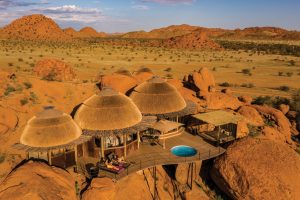
Camp Kipwe
Nestled against stunning boulders with sweeping views of the Aba Huab Valley, lies Camp Kipwe. Stepping into one of our 9 dome-shaped Bungalows, you will feel like you are entering a serene, cool cave. Relax on your veranda and become one with the breathtaking landscape. Tucked into the boulders, you are led from your room

Etendeka Mountain Camp
Etendeka Mountain Camp & Walking Trails Etendeka Mountain Camp, dramatically set in the foothills of the Grootberg massif in Northern Damaraland (Kaokoveld), appeals to the traveller who is prepared to step outside of their comfort zone and experience this remote wilderness with its harsh beauty in an authentic way. Here one is reminded that we
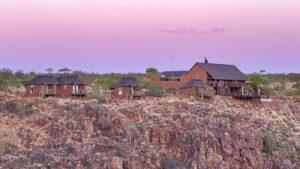
Grootberg Lodge
In the footsteps of giants Perched on the rim of the Etendeka Plateau, the Grootberg Lodge stands sentinel over the Klip River Valley. Fourteen rock-and-thatch chalets and two family units gaze out over the gorge. Twelve thousand hectares have been set aside by the #Khoadi //Hoas community for conservation and tourism and it is
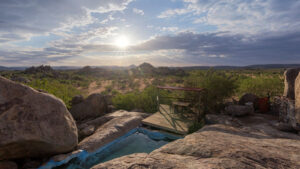
Hoada Camp
Between a rock and a hard place Hidden among large granite boulders and mopane trees, Hoada Campsite offers travellers a serene home in the wilderness. The area is rich in a variety of animal species, and offers spectacular views. This sensational landscape is a natural habitat of Namibia’s uniquely adapted desert elephant. We offer
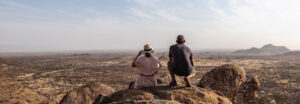
Hohenstein Lodge
The Hohenstein represents the impressive western edge of the Erongo mountain range. In the evening, spectacular sunsets above the desert plains bathe the mountain in a fantastic red light. Have a drink on the terrace and enjoy this exceptional view. Accommodation is offered in 14 spacious rooms, each with a safe, shaded terrace, and a

Khorixas Restcamp
In the heart of the arid central Namibia, between Swakopmund and the Etosha National Park, lies Khorixas Camp, a port of call that provides a relaxing environment for travellers weary after a day’s exploration. Near Khorixas is the Burnt Mountain, the Petrified Forest and the famous rock-engraving site at Twyfelfontein, Namibia’s first UNESCO World Heritage

Madisa Camp
Madisa Camp is located in the heart of Namibia’s north-western region, and is surrounded by ever-changing landscapes and desert-adapted wildlife. Dwarfed by massive rock formations and ancient mopane trees, Madisa Camp embraces its rugged environment perfectly. The Safari Tents are unique and built around scenic granite boulders, with an en-suite outdoor rock bathroom. The nine

Mowani Campsite
Mowani Campsite offers 7 sites with spectacular views. Set amongst the boulders, each site is private and has ablution facilities, kitchen area, braai and a shaded area with bench. Visit Mowani Campsite Book your Stay Adventure Experience Contact us Contact the listing owner to discover more or book your stay. Take me there! Click Here


